You are using an out of date browser. It may not display this or other websites correctly.
You should upgrade or use an alternative browser.
You should upgrade or use an alternative browser.
Prototype Tim Mills' Photos
- Thread starter oldravendale
- Start date
Lyndhurstman
Western Thunderer
Apropos the shiny smokeboxes; in preservation, we used to ‘paint’ the smokebox with cylinder oil as part of the prep. It made it shiny. And sticky!
Cheers
Jan
Cheers
Jan
Barry37
Western Thunderer
Only six Tierwags were built, which, given their complicated design, is not a surprise. The second wagon appears to be a Ten Ton Carriage truck to D1/089, or D1/095. The latter seems more likely, as these had shorter wheelbase bogies, which the wagon in the photo appears to have.That last picture is magnificent! Two different types of Carflat - the first a conversion from GW stock as the second might be, though to a different pattern (I don't know a lot about these). Behind them a pair of Tierwags which Tri-Ang made a representation of. Empty to Cowley, perhaps?
Adam
No sorry, totally co-incidentally our little wagon group has been discussing Tierwags today. The MAT had 25 built from 1957 - 9 followed up by the 6 BR ones. The BR one photographed in BR Wagons doesn't have the plate on the side, whereas the MAT ones do have a plate. Initially at least all were allocated to Morris Cowley traffic from Oxford. The MAT ones were used to the Continent; the Fiat works in Turin a known destination. All were built by Newton Chambers - who also built the better known BR Motorail vans with the lifting central section. Possibly short-lived, the BR ones had gone by 1971 and it is possible so were the MATs.Only six Tierwags were built, which, given their complicated design, is not a surprise. The second wagon appears to be a Ten Ton Carriage truck to D1/089, or D1/095. The latter seems more likely, as these had shorter wheelbase bogies, which the wagon in the photo appears to have.
Paul
Last edited:
Trev Mann and David Ratcliffe have both informed me that ICI had at one time had a break-bulk/distribution depot at Kentish Town which received solvents and chloro sulphur compounds from their works at Runcorn and Acton Grange. It is presumed this closed when the new ICI depot at Willesden opened.Paul and Overseer - thanks so much for filling in details about the tank wagons. An interesting subject indeed. I assume Trichloroethylene was towed around the country in such large volumes for the dry cleaning industry and it'd be unlikely that there'd be a need for it at an MPD - or was it perhaps used in one of the cleaning functions on shed? As for the possibility of the older wagons carrying phosphoric acid that would initially seem a possibility but their locations suggest they are in the shed yard rather than separated off for the bottling plant. We'll probably never know.
Paul
Barry37
Western Thunderer
Forgot that they were in BR Wagons "Vol. 1"- only looked in the Don Rowland "British Railways Wagons" book, which only hints at the existence of the MAT ones.No sorry, totally co-incidentally our little wagon group has been discussing Tierwags today. The MAT had 25 built from 1957 - 9 followed up by the 6 BR ones. The BR one photographed in BR Wagons doesn't have the plate on the side, whereas the MAT ones do have a plate. Initially at least all were allocated to Morris Cowley traffic from Oxford. The MAT ones were used to the Continent; the Fiat works in Turin a known destination. All were built by Newton Chambers - who also built the better known BR Motorail vans with the lifting central section. Possibly short-lived, the BR ones had gone by 1971 and it is possible so were the MATs.
Paul
Regarding model Tierwags, there may have also been something similar in the Playcraft range, around the time Playcraft was sold in Woolworths (1960ish).
readingtype
Active Member
Then perhaps this is Tier in the English sense of "Doppelstock"?I’m worried by (and ignorant of) Tierwags. “Tier” is German for “animal”.
From photos I've seen, the wagons in question seem remarkably overcooked in comparison to those introduced a bit later that have perforated sheet metal sides and decks that slope down towards the middle (resembling road based car transporter trailers...). Lots of those went to Cowley.
Ben
Osgood
Western Thunderer
CloseNumber two has it for me. Dramatic.

But it has to be number four for me.
I’m worried by (and ignorant of) Tierwags. “Tier” is German for “animal”. “Wags” is current slang for…
Tier, as in 2 tiers, ie, 2 levels.
Roja
Crimson Rambler
Western Thunderer
I was brought up at Elstree and well remember the last, fast declining days of steam on the Midland's London Extension. Tim Mill's evocative views of Kentish Town bring it all back as well as serving, with his other photos, as an invaluable archive for future modellers and historians alike shewing how it was at the end.
However, I do hope you will forgive me if I admit to a liking for an earlier Kentish Town when it looked completely different in all senses:-
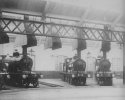
On the extreme left either a Princess of Wales 4-2-2 (probably) or a Belpaire 4-4-0 (possibly), then a 1853 class 4-2-2, a Class M 0-6-0 and a 2183 class 4-4-0 - then continuing:-
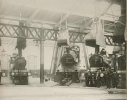
Resuming from the 2183 class 4-4-0, next is a 2781 class Belpaire under the shearlegs followed by a Princess of Wales 4-2-2 and finally finishing with either a 1853 class 4-2-2 or a 4-4-0.
Crimson Rambler
However, I do hope you will forgive me if I admit to a liking for an earlier Kentish Town when it looked completely different in all senses:-

On the extreme left either a Princess of Wales 4-2-2 (probably) or a Belpaire 4-4-0 (possibly), then a 1853 class 4-2-2, a Class M 0-6-0 and a 2183 class 4-4-0 - then continuing:-

Resuming from the 2183 class 4-4-0, next is a 2781 class Belpaire under the shearlegs followed by a Princess of Wales 4-2-2 and finally finishing with either a 1853 class 4-2-2 or a 4-4-0.
Crimson Rambler
oldravendale
Western Thunderer
Following my fishing trip to Cornwall such a lot of catching up to do.
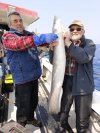
A conger eel around 30 lbs weight too heavy for me to lift on my own so I've enlisted the skipper's help. (I'm not the one in the middle). It was the biggest I've ever caught but still a tiddler as they are reckoned to grow to around 160 lbs.
(For those who are correctly of an ecological mind set please be assured that the fish was returned unharmed as were all the fish we caught during the weekend except for those kept for consumption or retained as bait).
However, back to matters photographic.
Thank you, Adam, Barry, Paul, Ben and Roja for filling in a lot of info about the carflats/Tierwagons - in fact the wagons in general.
Thanks also for the comments about the photos, smokeboxes and Caprotti Black 5s. All worthy discussion points and I've seen no knives out, so well done everyone.
Another thanks to Paul for info which may explain the presence of those tankers at Kentish Town - all added to the appropriate files.
Also my thanks to Crimson Rambler for those lovely, evocative photos in Kentish Town Shed. That shed master must have cracked the whip to keep the interior of the shed so clean and tidy!
We've seen A1 60121 Silurian previously in post #2540 but here it's on the 5.50 Grantham train at Hornsey on 1st September 1962. This had been a York North engine since delivered new in 1948 and was withdrawn in October 1965. (SLS). It was scrapped at T W Ward Killamarsh at the end of November. (Rail UK).
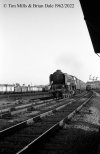
This A3 60111 Enterprise on the 6.12 Leeds train at Hornsey on 1st September 1962. We last saw this loco in post #2387. It had been at its final shed, Grantham, since 1957. It was withdrawn from there on 29th December 1962. It went to Doncaster for scrapping which was completed by early April 1963 (BR Database, SLS and Rail UK). Trough deflectors were not fitted until March 1962. (BR Database).
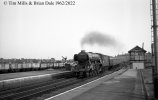
B1 4-6-0 61168 on the 6.17 Peterborough train at Hornsey on 1st September 1962. The loco had been based at Immingham since July 1953 and it was withdrawn from there in October 1965. (SLS). It was scrapped at T W Ward, Killamarsh in November 1965. (BR Database).
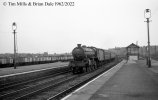
Brian

A conger eel around 30 lbs weight too heavy for me to lift on my own so I've enlisted the skipper's help. (I'm not the one in the middle). It was the biggest I've ever caught but still a tiddler as they are reckoned to grow to around 160 lbs.
(For those who are correctly of an ecological mind set please be assured that the fish was returned unharmed as were all the fish we caught during the weekend except for those kept for consumption or retained as bait).
However, back to matters photographic.
Thank you, Adam, Barry, Paul, Ben and Roja for filling in a lot of info about the carflats/Tierwagons - in fact the wagons in general.
Thanks also for the comments about the photos, smokeboxes and Caprotti Black 5s. All worthy discussion points and I've seen no knives out, so well done everyone.
Another thanks to Paul for info which may explain the presence of those tankers at Kentish Town - all added to the appropriate files.
Also my thanks to Crimson Rambler for those lovely, evocative photos in Kentish Town Shed. That shed master must have cracked the whip to keep the interior of the shed so clean and tidy!
We've seen A1 60121 Silurian previously in post #2540 but here it's on the 5.50 Grantham train at Hornsey on 1st September 1962. This had been a York North engine since delivered new in 1948 and was withdrawn in October 1965. (SLS). It was scrapped at T W Ward Killamarsh at the end of November. (Rail UK).

This A3 60111 Enterprise on the 6.12 Leeds train at Hornsey on 1st September 1962. We last saw this loco in post #2387. It had been at its final shed, Grantham, since 1957. It was withdrawn from there on 29th December 1962. It went to Doncaster for scrapping which was completed by early April 1963 (BR Database, SLS and Rail UK). Trough deflectors were not fitted until March 1962. (BR Database).

B1 4-6-0 61168 on the 6.17 Peterborough train at Hornsey on 1st September 1962. The loco had been based at Immingham since July 1953 and it was withdrawn from there in October 1965. (SLS). It was scrapped at T W Ward, Killamarsh in November 1965. (BR Database).

Brian
oldravendale
Western Thunderer
Here's an unidentified Hall on the down 4.15 Banbury train at North Acton on19th September 1962.
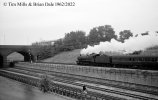
Two here of ex LBSCR K Class 32351 Light Engine at Willesden Junction Station on 19th September 1962. The second shot includes what I believe to be a Fairburn 2-6-4T. According to the SLS 32351 was allocated to Redhill in August 1948 and then the most unlikely Bushbury in May 1949! The given withdrawal date of November 1962 seems reasonable. WHTS seems to have a better handle on what happened as it advises via the SLS that the loco was in store at Three Bridges following withdrawal and on 20th January 1963 it was awaiting scrap at Eastleigh (SLS), a job completed in April the same year (BR Database).
The actual allocation is better sourced from the appropriate Locoshed Books and these show the loco to have been allocated to Three Bridges in April 1957, October 1957, April 1958 and November 1959. Couple this with the record that the loco was stored at Three Bridges suggests that this was the actual allocation although when it was transferred there from Redhill we don't know.
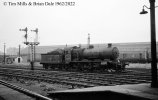
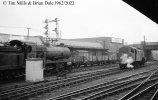
Ivatt 2MT 2-6-0 46424 in the bay platform at Willesden Junction Station on 19th September 1962. This was allocated to Willesden from May 1956, then Widnes in June 1963, Speke Junction in May 1964 and Workington in July 1965 where it was withdrawn in December 1966. (SLS). The Railway Observer report it went to Motherwell Machinery and Scrap, Wishaw and BR Database give the date of destruction as May 1967.
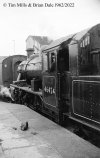
Brian

Two here of ex LBSCR K Class 32351 Light Engine at Willesden Junction Station on 19th September 1962. The second shot includes what I believe to be a Fairburn 2-6-4T. According to the SLS 32351 was allocated to Redhill in August 1948 and then the most unlikely Bushbury in May 1949! The given withdrawal date of November 1962 seems reasonable. WHTS seems to have a better handle on what happened as it advises via the SLS that the loco was in store at Three Bridges following withdrawal and on 20th January 1963 it was awaiting scrap at Eastleigh (SLS), a job completed in April the same year (BR Database).
The actual allocation is better sourced from the appropriate Locoshed Books and these show the loco to have been allocated to Three Bridges in April 1957, October 1957, April 1958 and November 1959. Couple this with the record that the loco was stored at Three Bridges suggests that this was the actual allocation although when it was transferred there from Redhill we don't know.


Ivatt 2MT 2-6-0 46424 in the bay platform at Willesden Junction Station on 19th September 1962. This was allocated to Willesden from May 1956, then Widnes in June 1963, Speke Junction in May 1964 and Workington in July 1965 where it was withdrawn in December 1966. (SLS). The Railway Observer report it went to Motherwell Machinery and Scrap, Wishaw and BR Database give the date of destruction as May 1967.

Brian
Heather Kay
Western Thunderer
Wow! The second shot of the K class appears to have a shock pallet van in the background. That’s quite a rare beast.
Martin Shaw
Western Thunderer
Some date variations and confirmations.
32351 Norwood Junc 1/1/48, Redhill 7/48, Three Bridges 4/49, Wdn 11/62. Longworth.
46424 Widnes 27/11/48, Crewe North (loan) 14/3/53, Willesden (loan) 28/3/53, Rhyl (loan) 25/7/53, Widnes 26/9/53, Willesden 28/4/56,
Widnes 25/5/63, Speke Junc 18/4/64, Workington 10/7/65, Stored serviceable 11/11/65 - 10/12/66, Wdn 10/12/66. Irwell book of.
Martin
32351 Norwood Junc 1/1/48, Redhill 7/48, Three Bridges 4/49, Wdn 11/62. Longworth.
46424 Widnes 27/11/48, Crewe North (loan) 14/3/53, Willesden (loan) 28/3/53, Rhyl (loan) 25/7/53, Widnes 26/9/53, Willesden 28/4/56,
Widnes 25/5/63, Speke Junc 18/4/64, Workington 10/7/65, Stored serviceable 11/11/65 - 10/12/66, Wdn 10/12/66. Irwell book of.
Martin
oldravendale
Western Thunderer
Thank you, Heather for identifying a vehicle about which I had no idea.
Also thanks to Martin for confirming the allocations of the K and also the full story of the Mickey Mouse.
8F 48136 on an up freight for Temple Mills at Willesden Junction Station on 19th September 1962 - I believe that's a "Skinhead" passing with freight on the High Level. 48136 was allocated to Rugby in January 1958. The SLS then advises it was moved to Widnes in February 1960 but I think that's erroneous - BR Database doesn't have that allocation and Widnes is rather too far from Willesden for that to be a practical allocation, although I suppose it's always possible that it made the trip in two or three hops and then was put to use by Willesden before returning it. However, sources agree with Carlisle Kingmoor in June 1963 and Newton Heath in August 1964 before withdrawal in March 1967. (SLS). It was scrapped at Cashmore's, Great Bridge, in July 1967.
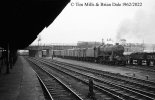
Royal Scot 46126 Royal Army Service Corps light engine at Willesden Junction Station and carrying a 1A Willesden shed plate with Engineers' wagons on the left on 19th September 1962. The lower right corner of this negative was damaged and I've painted it in. The loco had been on the Willesden allocation since February 1961, moving to Annesley in December 1962 before withdrawal in October 1963. (SLS). The Railway Observer reported the loco at Crewe Works in November 1963 and the SLS hat it was cut up there week ending 15th November 1963.
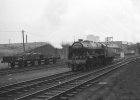
A4 60021 Wild Swan on the 6.26 York & Hull at Hornsey on 1st September 1962. This loco has been in these pages too many times to mention, one such mention in post #2279. In March 1962 it was allocated to Kings Cross and was moved to New England in June 1963 where it was withdrawn in October. (SLS). It was scrapped in January 1964 at Doncaster Works. (BR Database).
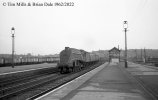
Brian
Also thanks to Martin for confirming the allocations of the K and also the full story of the Mickey Mouse.
8F 48136 on an up freight for Temple Mills at Willesden Junction Station on 19th September 1962 - I believe that's a "Skinhead" passing with freight on the High Level. 48136 was allocated to Rugby in January 1958. The SLS then advises it was moved to Widnes in February 1960 but I think that's erroneous - BR Database doesn't have that allocation and Widnes is rather too far from Willesden for that to be a practical allocation, although I suppose it's always possible that it made the trip in two or three hops and then was put to use by Willesden before returning it. However, sources agree with Carlisle Kingmoor in June 1963 and Newton Heath in August 1964 before withdrawal in March 1967. (SLS). It was scrapped at Cashmore's, Great Bridge, in July 1967.

Royal Scot 46126 Royal Army Service Corps light engine at Willesden Junction Station and carrying a 1A Willesden shed plate with Engineers' wagons on the left on 19th September 1962. The lower right corner of this negative was damaged and I've painted it in. The loco had been on the Willesden allocation since February 1961, moving to Annesley in December 1962 before withdrawal in October 1963. (SLS). The Railway Observer reported the loco at Crewe Works in November 1963 and the SLS hat it was cut up there week ending 15th November 1963.

A4 60021 Wild Swan on the 6.26 York & Hull at Hornsey on 1st September 1962. This loco has been in these pages too many times to mention, one such mention in post #2279. In March 1962 it was allocated to Kings Cross and was moved to New England in June 1963 where it was withdrawn in October. (SLS). It was scrapped in January 1964 at Doncaster Works. (BR Database).

Brian
AJC
Western Thunderer
Wow! The second shot of the K class appears to have a shock pallet van in the background. That’s quite a rare beast.
Yep - just 125 (built '61, to diagram 1/219 to lot 3347 - per @hrmspaul's webpages: BR Pallet shock vans VRV), so less than a year old when photographed, too.
The three plank in front of it seems to be another rarity, though there's another in the shot of 46126, a BR(?) built Haddock, just 50 of those and not, so far as I was aware, allocated to he Southern.
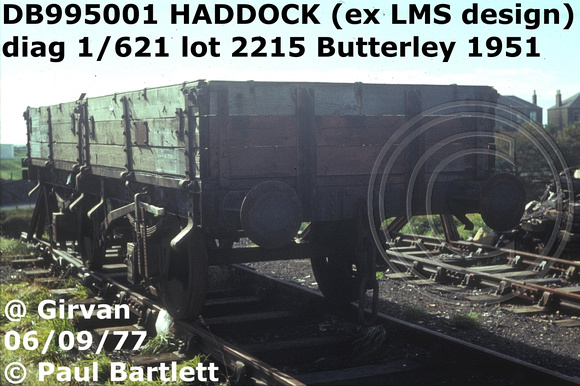
BR Haddock - Sleeper wagon ZCO
BR built a single batch of 50 of these sleeper carrying wagons, based on an LMS design. They were similar to the commoner Sole ballast wagons but had fixed ends. A variety of liveries is shown towards the end of their lives. A few lasted until the general demise of unfitted wagons.
paulbartlett.zenfolio.com
That said, you can't really make out the W irons so it might be an LMS build: 459 of those: LMS Haddock - Sleeper wagon ZCO
Adam
michael mott
Western Thunderer
From my perspective it's most rewarding to receive so many "Likes" for the photos on this thread and makes the continuing effort to show the photos really worthwhile. I'm also aware that there are a few who don't add their "Likes" but are regular viewers because of the comments they leave. Thank you all.
Larry - I never saw a B16 let alone rode behind one. I'd always thought of them as fast freight locos but like many others (LNER V2s, LSWR S15s and Black 5s) to name but three were capable of putting in passenger train performance when required.
This is one of the “Views inside the Roundhouse at Old Oak Common” on 21st October 1962. Although identification of the various locos is not possible the photo is a reminder of a working, busy and enormous MPD and for me exudes atmosphere.
View attachment 213946
Another view in Old Oak on 21st October 1962. The locos are clearly 15XX Class 0-6-0 PTs but not identified. A later photo (img2806) suggests the loco on the right could be 1504.
View attachment 213947
A very underexposed image inside the roundhouse at Old Oak Common on 21st October 1962. From the left Modified Hall 6988 Swithland Hall, another Modified Hall with a number starting 696- but not identified and Hall 4903 Astley Hall. Swithland Hall home shed was Bristol Barrow Road and it moved to Westbury in September 1963 where it was withdrawn on 5th October 1964. (SLS. It was then reported
These two photos bring back my mid teen trainspotting days, it was quite a walk from my home on Twyford Avenue up to old oak but happy days wandering around the roundhouse. My lack of awareness of how fast these scenes would fade away forever was in many ways ignorant bliss.
Michael
Martin Shaw
Western Thunderer
Brian
You might well think Widnes a mistake but apparently not, although as we have observed before which is the original source that has been quoted?
48136 Wellingborough 16/8/41, Kettering 16/5/42, Westhouses 7/8/43, Nottingham 8/3/52, Rugby 4/1/58, Widnes 13/2/60, Kingmoor 1/6/63,
Newton Heath 11/7/64, Wdn w/e 11/3/67. A pic I have shows it with a star on the cabside and hence balanced for pass working. Irwell book of.
Martin
You might well think Widnes a mistake but apparently not, although as we have observed before which is the original source that has been quoted?
48136 Wellingborough 16/8/41, Kettering 16/5/42, Westhouses 7/8/43, Nottingham 8/3/52, Rugby 4/1/58, Widnes 13/2/60, Kingmoor 1/6/63,
Newton Heath 11/7/64, Wdn w/e 11/3/67. A pic I have shows it with a star on the cabside and hence balanced for pass working. Irwell book of.
Martin
